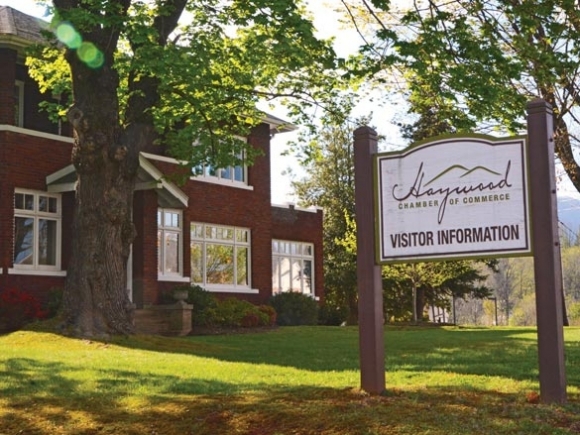What’s in the cards? Chamber, EDC try to stack the deck in Haywood’s favor

Among the various organizations involved in economic development, one often finds a Chamber of Commerce and some development organization.
Although every city, state and county does things differently, Haywood County has both an active Chamber of Commerce as well as an Economic Development Council.
Economic development efforts locally are certainly a team effort, but the unique partnership between the Chamber and the EDC has begun to yield the kind of results this rural Appalachian community needs to remain economically relevant and competitive.
It takes two
“Our total budget right now is about $260,000. We do a lot of work for that $260,000,” said CeCe Hipps, president of the Haywood Chamber of Commerce.
A 501(c)6 nonprofit subject to board governance, the chamber focuses on increasing the vitality of the county’s economic environment by providing opportunities for networking, marketing and professional development, all on that relatively slim yearly budget.
Related Items
“Budget is always a problem for us,” Hipps said. “A lot of people don’t seem to understand that. If you look at it as a pie, part of that pie comes from membership dues, part of it comes from sponsorships and part of it comes from event revenue.”
Although there are other “slivers” of revenue, they are just that — slivers — according to Hipps.
“The county gives us a little, $8,000 a year,” she said. “The town of Waynesville currently does not give us any money, which is highly unusual for a chamber not to receive support from their main municipality or county seat.”
Thus the importance of the chamber’s yearly events — Melange in the Mountains, the Gatweay to the Smokies Half Marathon and 4-Miler, the Apple Harvest Festival and its golf tournament.
“The Apple Festival has grown from a small little venue for apple growers,” Hipps said. “The first year that I was here, it was about 70 vendors. Now it’s over 150. Melange is designed to bring people into restaurants during the off-season, and this year, Gateway to the Smokies I think had more than 130 participants.”
Hipps estimated that more than 50 percent of runners were from outside of Haywood County, meaning that while they support the chamber’s activities, they also support local hotels, B&Bs, bars and restaurants.
But a lot of people, Hipps said, see her organization as an “events only” chamber.
“We’re trying to break that perception,” she said.
One focus of the chamber is strengthening existing businesses; the Chamber Learning Network makes educational attainment achievable for the busy professional.
“The reason we started doing the webinars and the online courses is that not all of our members have time during the day to attend a seminar or to participate in lectures,” she said. “There are webinars that are free and they’re usually like 10-minute videos.”
The webinars offer topics like basic accounting, financial services, human resource management and risk mitigation; other classes available for a fee address a variety of workplace topics including sexual harassment, performance measurement and even what to do in the case of an active shooter.
One claim on the chamber’s website says that companies utilizing such tools “have the potential to boost productivity by up to 50 percent.”
While the chamber’s resources may be attractive to local businesses, they’re also proving helpful in drawing visitors to Haywood County.
“It’s been a tourist destination the whole time,” Hipps said. “That started back when people would arrive here in the summertime on the train.”
Certainly, there’s lots to offer. When asked why anyone should visit Haywood County, Hipps simply said, “Well why wouldn’t they?”
The county is home to a thriving restaurant and craft brewing scene; wedding venues are plentiful as are lodgings to suit any budget; shopping districts in Waynesville, Canton and Maggie Valley are bustling; arts and cultural attractions like HART, The Strand theater and Folkmoot offer high-quality entertainment; and there are few better places to drive or ride a motorcycle in the entire country.
SEE ALSO: Distillery hopes to pack economic punch
And then, of course, there’s the majestic natural appeal of the region.
“You’ve got beautiful mountains, you’ve got the Great Smoky Mountains National Park and the Blue Ridge Parkway,” Hipps said. “It’s definitely a draw. And Asheville has helped a lot. With all the attention they get as a big city now, it bleeds over into our community.”
The pipeline of visitors bleeding over into Haywood County naturally leads to some of them deciding to make the place their home.
“There has been a significant increase in people that are looking to relocate here,” Hipps said. “Personally, I’ve talked with two individuals who were considering moving here in the first three days of this week alone — one from Pennsylvania, and one from Kentucky.”
Attracting new residents is important to the county; a study recently published by the Haywood County Affordable Housing Task Force said that the rate of natural population increase in the county can’t sustain the existing population alone.
If the county — and the county’s tax base — is to grow, it must do so because of people moving here, not being born here.
“A lot of times, what we’re doing is trying to very tastefully direct people to the conclusion that they want to be here,” Hipps said. “Our job is to sell Waynesville, without hurting my friends that are in Brevard and Blowing Rock, because they’re doing the same thing I’m doing.”
Hipps emphasizes the differences in regional communities so prospective residents can make better decisions on which mountain lifestyle might be best for them.
“It’s simple things — like Hendersonville is going to be 5 or 6 degrees warmer, and their traffic is an issue for them,” she said. “The retiree population is large, and it’s a larger place. So we just try to highlight the differences in a very tasteful manner.”
The chamber’s focus on member services and residential relocation is important, but isn’t the only way Haywood County seeks to foster growth.
The chamber’s counterpart in economic development — the Economic Development Council — has been in existence since the mid-1980s, but has experienced recent changes aimed at streamlining development and working more closely with the chamber.
“Three years ago this July, Haywood County’s Economic Development Commission became the Economic Development Council,” said Mark Clasby, executive director of the EDC.
“It wasn’t a money thing,” Hipps said. “It was purely a way to improve the program and to look at things a little bit differently. Other than that, it still operates pretty much the same.”
A minor change in name belied a major change in structure; formerly under the auspices of Haywood County, the commission merged with the Chamber of Commerce to become the council, reflecting a recent trend among larger municipalities of marrying the two organizations.
“When this merger first took place, it was a transition to emerge or meld the two together,” Hipps said. “We were kind of doing the same thing, but since we’ve been together, now it works more seamlessly as one organization, which is the beauty of what we do.”
Clasby, in contrast to Hipps, focuses on larger companies with questions about land, infrastructure and incentives.
“His issues are complex and sometimes very difficult, and it takes a long time to resolve some of those issues,” Hipps said. “On our side, our main focus is to help our membership base, but even though we cross that line and will help any business, we want to get information to our businesses and opportunities for them to grow and be successful in Haywood County.”
What Hipps and Clasby do have in common is that residents bring jobs, and jobs bring residents; the two sides of that equation are always interrelated and serve as a great example of why Clasby and Hipps — certified economic developer and a certified chamber executive, respectively — now operate as a pair.
“When someone comes in the door and they’re tourists but they’re thinking about moving here, I grab them,” said Hipps. “When someone comes in the door and they’re thinking about moving a business in, he grabs them. Then if we have questions and want to brainstorm, it’s just walking across the hall, instead of calling on the phone.”
The EDC — which is funded by the county to the tune of about $220,000 annually — seeks to support existing industries while also enhancing capital investment, encouraging job creation and creating an environment where entrepreneurs can flourish.
Clasby’s attractions, however, are somewhat different than Hipps’; Haywood County’s top-10 percent public school system and robust health care system are important factors to companies seeking to locate or expand in the county, as is the easy ingress and egress to two major interstates that provide access to 50 percent of the U.S. population in less than a day’s drive.
These factors are probably important to Publix, the Lakeland, Florida, based grocer planning to open a Waynesville location soon; Clasby said his organization didn’t have much to do with luring them here, but indirectly, the chamber’s and the EDC’s work to help create the kind of environment Publix would consider certainly did.
But just because the EDC no longer operates under the county doesn’t mean the county’s not involved in economic development.
Haywood Tax Assessor David Francis plays an important role linking the chamber, the EDC and Haywood County, which has the power to offer important incentives to induce businesses to consider the area.
“Beginning in the early part of 2016, Ira [Dove, Haywood County’s manager] and then-Chairman Mark Swanger wanted a liaison to work with the EDC and the chamber and various groups on the tax side, helping those entities that are coming in move through the process,” Francis said. “You can see when you start doing this the team effort it takes, moving through the various county offices, talking to the state Department of Transportation or the state Department of Environmental Quality.”
Whether it’s giving businesses a chance to sit before the planning department or navigating the building inspection process, Francis helps businesses move through the distinct layers of government.
And he’s been busy. “I’ve worked for three or four businesses now, getting then moved over,” he said. “From a business owner’s perspective, sometimes they don’t understand the bureaucratic red tape inherent in governments when you try to get things done. So I think that having that person with boots on ground helps them a lot — somebody to hold their hand a little bit, and marshal the county’s resources to get these things done.”
Francis said he’s working with three businesses right now, two of which are “sizeable.”
“Each one of them has a different set of challenges,” he said. “That’s what makes the job really fun and interesting is that there are unique challenges to each of the businesses, and how do we work through those things?”
A prime example was when Clasby and Haywood County lured Western Carolina Freightliner to Canton from Asheville late last year; the site they chose off Interstate 40 needed some infrastructure improvements, which were paid for by the county and the town.
But the challenges to an established business like WCF are far different than those faced by emerging businesses.
“We wanted to try to incentivize people to complete a business plan,” Hipps said of the chamber’s Business Start-up Competition, which has taken place every year since 2004. “If you do a business plan, your chances of success are better. So this is a way of motivating people to complete a business plan, to get some help from the community college and to enter into the competition for a chance to win $10,000.”
Last year’s winner, a wedding venue called Chestnut Ridge in Canton, is preparing for a grand opening in the coming weeks, as is the winner of the 2015 competition, a whiskey distillery in Maggie Valley (see Distillery, page 9).
“The success rate is very high for that program,” Hipps said. “In other years that we’ve worked on it, sometimes it happens and you don’t see [the businesses] anymore, but that doesn’t mean it wasn’t a success. Four businesses have gone out of business, and those businesses were the ones that started during the recession.”
Building a buttress against recessions, depressions, downturns, natural disasters, and other economic calamities is, in a nutshell, what Clasby and Hipps try do through the EDC and the chamber.
But as their unique, effective partnership continues to flourish, other factors — emanating from state and national economic development organizations — invariably affect the economic development environment in Haywood County.
Next week’s installment in this ongoing series on economic development will explore these effects, as well as try to answer the question economic developers in the region have been asking themselves for years — is the grass always greener on the other side of the county line?









